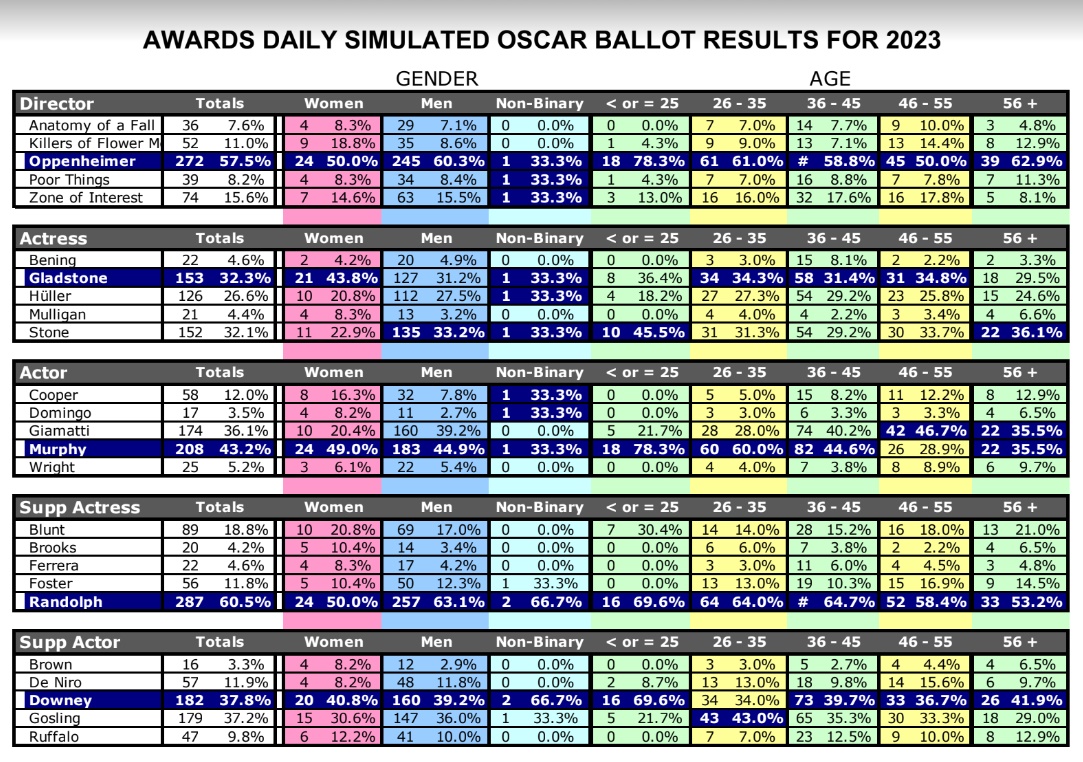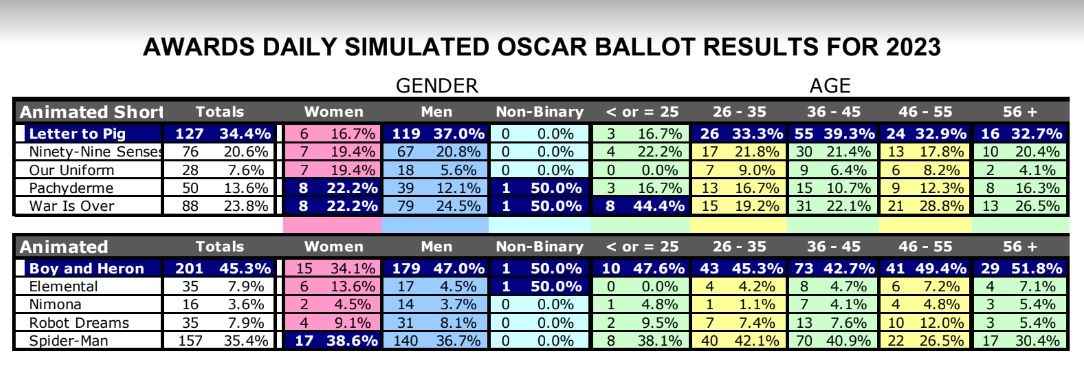This time last year it was impossible to deny that Everything Everywhere was a unique and extraordinary phenomenon.
One contentious year later, we’re in a situation the blows the extraordinary uniqueness of 2023 out of the water. The huge head-start numbers we saw breaking ahead for frontrunners last year pale in comparison to the way this year’s locks became so unassailable. While last year’s tight races look loose next to this year’s closest rivalries.
Once again Dr. Rob has devoted hours and hours of his time collate, tabulate, and calculate the mind-boggling math to give us the final results of our 17th annual Awards Daily Oscar Ballot experiment.
There’s a lot for us to digest in all the various analysis posts on site this weekend, so I’ll keep my thoughts brief and let you guys discover the dynamics happening in the tallies on your own.
Two things I’ll mention to help us wrap our heads around what we’re seeing this year.
Last year, Everything Everywhere got 40% of the ballots in the first round and Tar was a distant 2nd with 17%.
This year — with ostensibly stronger (and stranger) competition — Oppenheimer still managed to take 38% of the ballots in the first round of counting. All the same Oppenheimer’s 38% chunk of the ballots outweighed the next 4 contenders combined. No other movie had the slightest chance to catch up.
Clearly it was all over except for the counting — as the preferential redistribution system requires that a film must past 50% before it’s declared the winner.
As further proof that it’s virtually impossible for any movie to win Best Picture in the first round — you can see that it took Oppenheimer 8 rounds of redistribution before it could hit that magic number. (last year, EEAAO passed 50% in 7 rounds.)
And how stunning is it to see that our presumed top rivals landed so low in the first round? The Holdovers at #4? Barbie starting out with only 5% of our voters putting it at #1 on your ballots> Only 1% of us saying American Fiction was our #1 favorite of the year?
How surprising and refreshing to see the two international films break out of the starting gate at #2 an #3?
2nd category that jumps out at is in the hotly contested battle for Best Actress. We’ve all known for months that it would come down to Lily Gladstone and Emma Stone, but I think many people will be surprised to see how Sandra Huller made it a 3-way race. In fact, a snapshot of the results that Rob shared with me 3 days before the ballot deadline showed all 3 actresses each garnering around 30% of the votes. In the final stretch Emma and Lily pulled ahead, but the gap between them was always razor thin.
And take a look at the final numbers. 32.3% to 32.1% — Gladstone won by 2/10ths of 1 percent. Furthermore, shockingly, in raw numbers, it looks like Lily Gladstone prevailed with a lead of 1 single vote.
If something this close were to happen with actual Oscar ballots, would the Academy declare a tie? Surely they would.
In more general terms, what I love about Rob showing us these numbers is how it serves as a reminder that the “Best” in any category can rarely take home an Oscar with a majority of the votes. This year’s results show us once again that it’s possible to win an Oscar even if 2/3rds of the Academy voted for somebody else.
With these springboard first impressions of mine to get us started, we look forward to hearing more deep-dive analysis by you, the voters, our longtime friends and loyal readers here at AwardsDaily.
Thank you so much, Rob, for another fantastic lesson in the inner workings of all the ballot-shuffling and number-juggling that it takes to build the Oscar winners. We’re all forever grateful for the tireless effort and patience it take for you to give us this opportunity for nearly two decades.




















